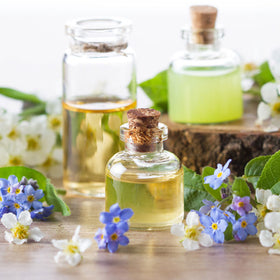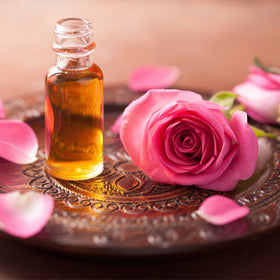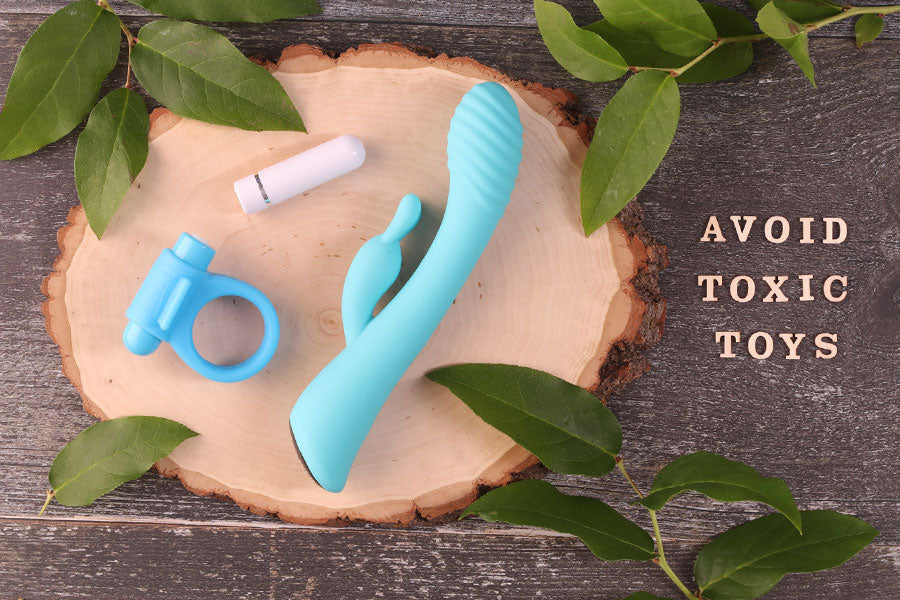Trusted for 25+ Years
Flavored Lubricants Guide

Dr. Lisa Lawless, CEO of Holistic Wisdom
Clinical Psychotherapist: Relationship & Sexual Health Expert

What We Will Cover
Flavored lubricants must taste amazing but must also be healthy for ingesting. Before getting into the nitty gritty, please note that all of our lubricants are safe to ingest in reasonable amounts.
We don't carry any lubricants with parabens and have meticulously selected the most secure, health-friendly ingredients. So, savoring the perfect flavored lubricant isn't just about an exciting taste adventure; it's also about relishing the peace of mind that comes with health-conscious choices.
In this guide, we will review lubricant factors from the mouthwatering goodness of sweetener flavor profiles and ingredients to the nitty-gritty details of osmolality and pH levels.
What You Need To Know
It's more complex than you'd think when embarking on the delicious journey of flavored lubricants. Some are amazing, while others have cheap ingredients and disregard for good sexual health.
There's also a swirling whirlpool of myths and misinformation about ingredients found in flavored lubricants, which have left consumers afraid to use perfectly healthy products. But rest assured, plenty of these flavor-infused wonders are concocted with your health in mind, striking a harmonious balance between pleasure and well-being.
Now, let's talk flavor. The ultimate deal-maker or breaker. With many tasting like cough syrup or worse, it can be a turn-off for many. That is why finding a satisfying consistency and flavor is also vital to enhancing your sexual experiences.
Why Use Flavored Lubricants?
Flavored lubricants can elevate oral sex adventures with external erogenous hotspots, like nipples, penis, vulva, and anus, by layering on a luscious blend of slick hydration and mouth-watering taste.
In addition, having extra moisture can make moving your mouth more effortless for better fellatio, cunnilingus, or analingus. Plus, flavors can add to the sensual foreplay, making your intimate moments even more adventurous and creative.
Edible Vs. Tasteable Lubricants
There's an important distinction to make in understanding the difference between lubricants that are genuinely edible and those that are merely tasteable.
Edible lubricants are explicitly designed to be consumed. They are not just about adding a tantalizing taste or aroma; rather, they are created with food-grade ingredients that are generally regarded as safe to eat. They often come in an array of mouthwatering flavors, from classic vanilla to exotic pomegranate, to make your sexual adventures more delicious.
On the other hand, tasteable lubricants are primarily meant to enhance glide and comfort during intimate activities, with a hint of flavor or scent to add a touch of fun. However, their formulas aren't designed to be consumed in significant amounts or used for oral sex.
Misunderstanding the difference between the two could, at best, result in a less-than-pleasant aftertaste and, at worst, cause an upset tummy or other adverse reaction.
Most Loved Lubricant Flavors
In the realm of intimacy, flavored lubricants can certainly spice things up. So, let's dive in and explore the best-performing flavors that most couples choose to enjoy.
Strawberry
A classic favorite, strawberry-flavored lubricant is like a romantic dessert, adding a sweet dimension to your intimate experiences.
Vanilla
Elegant, creamy, and comforting, vanilla is a go-to for those who enjoy a subtly sweet note in their encounters.
Cherry
A bit tart, a bit sweet, and wonderfully bold, cherry can make your intimate moments feel like a playful escapade.
Mint
Cool and refreshing, mint lubricant can bring a stimulating sensation that adds a bit of a exhilaration to your playtime.
Chocolate
Rich and indulgent, chocolate-flavored lubricant is like a delicious, decadent treat for your senses.
Watermelon
For a taste of summer any time of the year, watermelon offers a refreshing and fruity note.
Coconut
If you're yearning for a tropical escape, coconut-flavored lubricant can transport you to a beachside paradise in your very own bedroom.
Raspberry
Zingy and sweet, raspberry can add a burst of fruitiness to your sensual explorations.
Peach
With a sweet and slightly tart flavor, peach lubricant can bring a dose of Southern charm to your intimate experiences.
Caramel
Perfect for those who enjoy a sweet, buttery delight, caramel adds a hint of dessert decadence to your intimate moments.
Sweetener Myths
At our heart and soul, we're a holistic company that's deeply passionate about healthy, natural, organic ingredients. We value your health, always going the extra mile to ensure our products are of the highest quality.
However, some myths have made consumers unnecessarily fearful of certain ingredients, so we wanted to take the time to review science-based information to pave a clearer path through the fog of misinformation.
There are three artificial sweeteners commonly found in personal lubricants, aspartame (NutraSweet®, Equal®), saccharin (Sweet'n Low™), sucralose (Splenda®), and the natural sweetener steviol glycoside (stevia).
Let's peel back the layers on these sugar substitutes, debunking a few myths and confirming some facts to give you a sweeter understanding of your options.
Aspartame
Aspartame (NutraSweet®, Equal®) is an artificial sweetener with a negative reputation based on a 2006 study on rats showing an increased risk of cancer. However, that is not the end of this story.
The internet can be a wild place, a breeding ground for rumors and whispers. And aspartame has not been immune to this. There were also a lot of rumors on the internet that aspartame caused congenital disabilities, brain cancer, Alzheimer's disease, multiple sclerosis, and seizures.
However, these stories have no solid evidence to back them up. So as we explore the world of flavored lubricants, remember, it's key to discern the verified facts from the unproven chatter.
In 2007, the organization, Critical Reviews in Toxicology reviewed this information. They sorted fact from fiction, sifted through the data, and guess what they found? There was no credible evidence indicating the carcinogenicity of aspartame.
However, it should be noted that some people with a genetic disorder called phenylketonuria (or PKU) cannot metabolize phenylalanine and should avoid aspartame.
Scary Headlines In 2023 Are Not What They Seem
In June 2023, the IARC has recently categorized aspartame as a Group 2B carcinogen. What's the scoop on this? Well, it's not as intimidating as it sounds.
Diving straight into the heart of the matter, it is essential to understand the meaning of these IARC classifications. The IARC evaluates various substances, placing them into distinct classifications based on evidence of their carcinogenic properties in humans. A crucial aspect of these classifications is their focus on hazard, not risk. Risk considers the dose, while hazard doesn't.
Since 1981, the food safety champion, JECFA, has given the green light to aspartame. Their research has shown that it's perfectly safe to indulge in as long as we stay within sensible daily limits.
To put it into perspective, if you're an average-sized adult, you're looking at a safe aspartame quota equivalent to guzzling down anywhere between 12 to 36 cans of your favorite diet fizzy drink per day! That's a whole lot of soda and certainly more than anyone would reasonably consume.
Once we consider these factors, it becomes more apparent there isn't necessarily a safety concern. Aspartame is among the most studied food additives, so there's no lack of evidence.
Several extensive epidemiological studies involving hundreds of thousands of people have failed to establish a connection between aspartame and various types of cancer. Therefore, although the headlines might seem daunting, it's vital to understand these IARC classifications and the importance of dose.
Think of it this way, even our life-sustaining water can flip the script and play the villain if you decide to down gallons in one go. That's right, too much of a good thing can even be toxic, such as water poisoning (hyponatremia).
Saccharin
Back in the disco-drenched year of 1977, Canada banned saccharin. Then, in 1980, the World Health Organization (WHO) and the International Agency for Research on Cancer (IARC) listed it as a possible human carcinogen. Sounds bad right? So, let's look at this more closely.
How was this determined? Well, that is important to understand. They fed rats extremely high doses of saccharin, and an uptick in bladder cancer cases was noted. Again, high doses of many things can cause health problems, so what happened next with fears about its safety in the 70s and 80s is of no surprise.
Since then, several studies, such as those done by the US National Toxicology Program (NTP), found that the adverse effects were only in rats because of their unique urinary system, and the results could not be duplicated in mice.
In addition, the amounts of saccharin consumption in the rat studies were incredibly high and would never compare to what a human would consume.
Additional studies also showed that cancer rates among diabetics who consumed more artificial sweeteners such as saccharin were at no higher risk for cancer than the general public.
As a result, saccharin was removed from the Report on Carcinogens (RoC) in 2007, and the IARC removed it from carcinogen labels.
Steviol Glycoside (Stevia)
Steviol glycoside (stevia) is a natural sweetener derived from a perennial shrub of the aster family. Each tiny granule of stevia holds an enchanting secret which is that it's brimming with compounds that are 150 to 400 times sweeter than traditional sugar.
Stevia sweetens without calories and has been deemed safe to consume. It can be an excellent additive for flavored lubricants to sweeten them. Some people taste a slightly bitter taste after tasting stevia, while others do not, so if you are not a fan of stevia, avoiding lubricants with that as a sweetener may be a better option for you.
Stevia is generally safe for most people; however, it can lower blood pressure and cause allergies for those allergic to plants in the Asteraceae or Compositae families (chrysanthemums, ragweed, marigolds, daisies, etc.). Allergic reactions can typically be seen in mild skin rashes and headaches.
Sucralose
After 20 years of research and more than 100 safety studies, sucralose has been determined to be safe. In 1998, the FDA approved its use, as has the Joint FAO/WHO Expert Committee of Food Additives (JECFA), the FDA, Health Canada, the Scientific Committee on Food of the European Commission (SCF), and the Food Standards of Australia and New Zealand (FSANZ).
Sucralose's safety is recognized far and wide, crossing geographical boundaries. Over 100 countries, each with their own stringent food safety regulations, have given the nod to this sweet ingredient.
Animal studies have indicated that sucralose may change your gut microbiome, causing inflammation, obesity, and diabetes. However, conclusions from observational research have often been found to conflict with data from randomized controlled trials.
Furthermore, sucralose is not metabolized by gut microbiota, and human studies with repeated sucralose consumption have not shown any meaningful effect on the gut microbiome.
Artificial Sweeteners & Weight Gain
A PubMed.gov article called "The Impact of Artificial Sweeteners on Body Weight Control and Glucose Homeostasis" addresses the concern that artificial sweeteners cause weight gain.
However, studies that have been done on the effects on body weight control, glucose homeostasis, and underlying biological mechanisms are shown to be conflicting.
While there have been many rodent studies, long-term studies in humans are sparse, and most clinical studies show no significant effects on body weight and glycemic control. Thus, based on current research, it is not accurate to claim that artificial sweeteners cause weight gain.
Erythritol In Flavored Lubricants
Before discussing erythritol in detail, let's first answer an important question. Do we sell any lubricants that have erythritol in them? The answer is no.
This is not because of the 2023 study that outlines cardiovascular concerns but because erythritol is a sugar alcohol and a type of carbohydrate, and carbohydrates can provide a food source for yeast and bacteria.
Thus, using a personal lubricant containing erythritol could potentially increase the risk of yeast infections or other types of infections in the genital area. Additionally, erythritol can be drying and may diminish lubrication for sexual activity. Therefore, it is generally best to avoid using flavored lubricants with erythritol for these reasons.
To learn more about it, please see our guide: Is The Sweetener Erythritol In Your Flavored Lubricants And Should You Be Worried?
Glycerin & Yeast Infections
Another myth that is quite popular on the internet is that any glycerin in a lubricant is essentially sugar and can cause a yeast infection. While it is true that yeast infections can be caused by exposing the vagina to sugar, pharmaceutical or medical-grade glycerin is not a sugar nor toxic, rather it is a naturally occurring sugar alcohol compound.
The truth is that what consumers should be concerned about is cheap, substandard glycerin which can create an unhealthy vaginal or rectal environment because it raises osmolality.
Medical glycerin is typically used for treating glaucoma and reducing pressure in the eyes. Pharmaceutical glycerin is used as a sweetener in cough syrups, throat lozenges, gel capsules, vaginal and anal suppositories, eardrops, skin creams, and eyewash solutions.
If the glycerin is vegan, ultra-pure, and pharmaceutical or medical grade, using it in a personal lubricants may be acceptable if it has not raised the osmolality to an unhealthy level. If it is food-grade glycerin containing fatty acids, it may more likely contribute to increased osmolality and a yeast infection.
Pharmaceutical & Medical Grade Glycerin
Unless you have verification from a manufacturer, there is no way to know if your product's glycerin is pharmaceutical or medical grade. Therefore, unless a manufacturer can verify that it is, you may wish to avoid it.
Important Considerations
Not For Vaginal & Anal Penetration
Lubricants have different pH levels based on whether they will be used vaginally or anally. Flavored lubricants may or may not have the proper pH level for the orifice being penetrated.
Therefore, it may be best to primarily use flavored lubricants externally on the nipples, penis, labia, clitoris, and anus rather than inside the vagina and rectum. Using lubricants specifically for anal and vaginal penetration is more ideal.
Vaginal Dryness
If you are experiencing vaginal dryness and want to use a flavored lubricant, the most critical factors will be moisturizing ingredients, proper pH balance, and osmolality.
You may want to use a moisturizing lubricant in addition to using a flavored lubricant for added sensual fun to ensure that you are providing enough soothing ingredients.
Keep in mind that flavored lubricants should primarily be used on the external parts of the female anatomy, which includes the labia and clitoris. It is not meant for internal vaginal use.
Sex Toys
Water-based flavored lubricants are safe to use on sex toy materials. However, if you use an oil-based flavored lubricant, you will want to avoid exposing sex toy materials such as porous TPE and TPR elastomers.
Remember, when the path seems uncertain regarding what type of lubricant to use, water-based lubricants emerge as the all-weather friend, as they are the most compatible lubricant with all sex toys.
Safe Sex
Flavored lubricants can enhance the enjoyment of barrier methods, such as condoms and dental dams, thereby promoting safer sex practices. However, navigating the world of condoms can be a bit like finding your way through a maze, especially when mixing and matching lubricants and sex toys.
If you use latex or polyisoprene condoms or dental dams, you should avoid oil-based flavored lubricants, as oil will break down latex and polyisoprene, making them deteriorate.
If you use polyurethane condoms, you will have to check with the specific manufacturer because it will depend on the brand. So, don't hesitate to take a quick peek at the lubricant's compatibility with such condoms, as it could very well save the day!
For more information about this, please see our helpful guide: The Myth About Polyurethane Condoms & Lubricants.
Preventing Infections & Illness
Lubricants do not neutralize bacteria, so proper hygiene of the genitals or anus before oral sex can prevent health risks.
But let's not forget about your mouth, as brushing your teeth and using mouthwash can help to prevent urinary tract infections (UTIs).
In addition, urinating after oral sex can also help remove unwanted bacteria from the urethra.
Adverse Effects
Lubricant poisoning from any lubricant is highly unlikely; however, some people experience irritation from some of the ingredients. This does not necessarily mean that an ingredient is toxic.
For example, some warming lubricants contain cinnamon which can irritate the mucous membranes of the throat, vagina, and rectum. To prevent adverse effects, do spot tests on your arm to test for sensitivities, use small amounts of warming, cooling, stimulating, and flavored lubricants, and follow the manufacturer's guidelines for proper use.
If swallowed in large amounts, lubricants can cause nausea, vomiting, and diarrhea. If you have any of these symptoms or other irritation even when using small amounts, discontinue use and consult your physician.
Lubricants Ingredients To Avoid
Most of us have become accustomed to checking the labels for healthy ingredients, personal sensitivities, and dietary preferences when choosing our food, and selecting a flavored lubricant is no different.
Just like picking a gourmet dessert, your selection of flavored lube deserves a discerning palate. Peek at its ingredient list with as much care as you would when choosing a ripe avocado or selecting a bold red wine. This way, you're ensuring not just a delicious choice but a safe and satisfying one that aligns with your unique needs.
If you are unsure, based on a health condition, make sure to review it with your doctor. For help in discussing this sensitive topic, please see our helpful guide: How to Talk To Your Doctor About Sex.
Being a savvy consumer is the key to finding a good, health-conscious lubricant. Know your ingredients, folks! A few culprits often sneak their way into lubricant formulations and can create less-than-ideal conditions for your delicate vaginal and rectal environments. Let's shine a light on them:
- Nonoxynol 9
- Chlorhexidine Gluconate
- Polyquaternium-15
- Sugars & Sugar Alcohols
- Ureas
The Best Tasting Lubricants
We don't like wasting our consumer's time with trendy, cheap sexual products because they look or sound fun. Instead, we opt for a curated approach, handpicking only the premium and health-centric products for your well-being and satisfaction.
We also have a three-strikes rule which means that if any of our products get three negative reviews, we pull it. As we see it, there is no point in selling something people don't like. This means that all of our flavored lubricants are the best tasting on the market and have the healthiest ingredients you can find.
Thus, you get to skip the homework because we've done it all for you. Welcome to a sexual wellness company where quality takes the spotlight and your time and health are respected.





